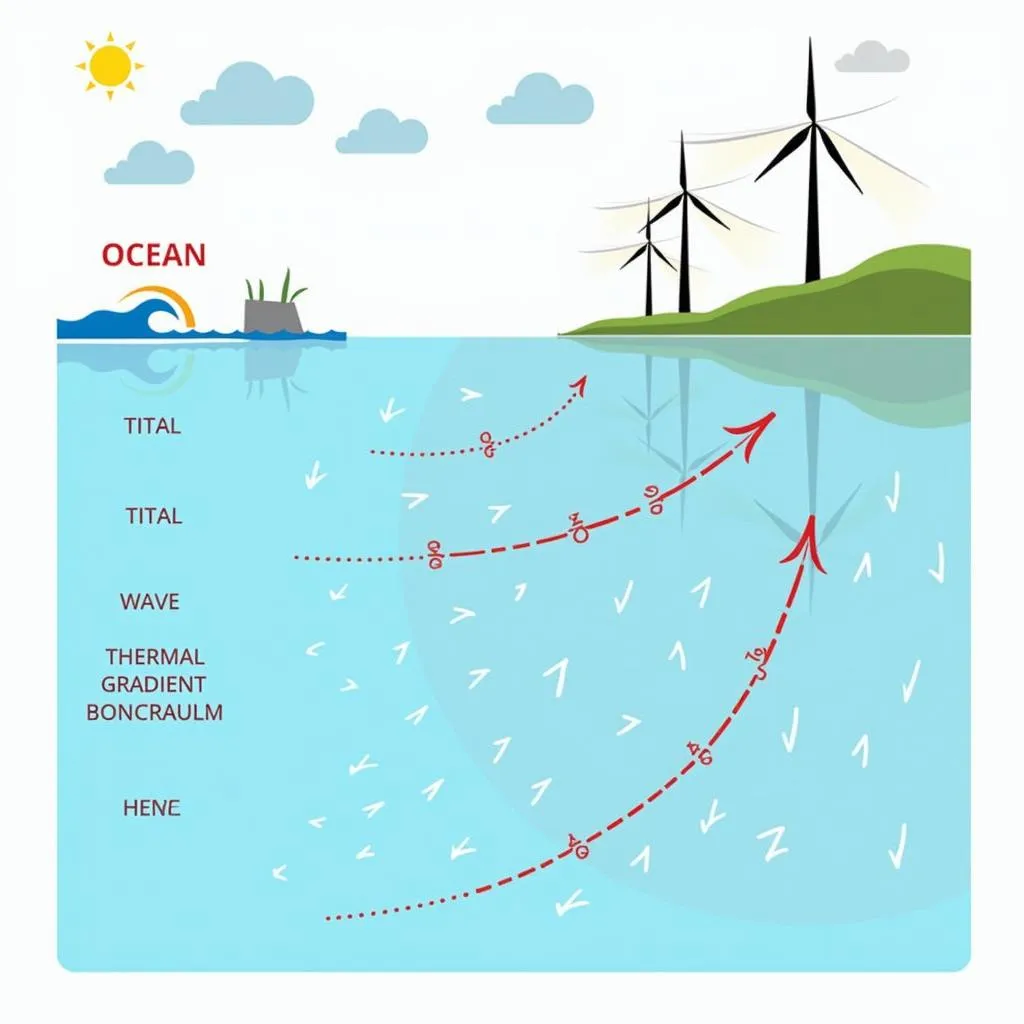In this article, we will explore the topic of oceanic energy sources, which comes with growing global attention around renewable energy. Alongside, you will find customized test questions based on real-world scenarios and sample responses ranging from different score bands.
Oceanic Energy Sources and Their Growing Potential
Oceanic energy is a promising renewable energy source, offering significant potential for large-scale electricity generation. Harnessing energy from oceanic sources—such as tides, waves, and thermal gradients—can provide clean, sustainable power. As the global demand for alternative energy grows, marine-based energy solutions could play a crucial role in reducing dependency on fossil fuels and mitigating climate change. These renewable energy methods are not only beneficial for countries with vast coastlines but also for the protection of marine ecosystems through responsible implementation.
 Ocean energy sources diagram and their mechanisms
Ocean energy sources diagram and their mechanisms
Now, let’s practice a sample Summarize Written Text on this topic.
Task Example 1: Summarize Written Text Question
The world’s vast ocean resources offer a major renewable energy opportunity, with tidal energy, wave energy, and ocean thermal energy conversion (OTEC) being the prime contributors. Tidal energy exploits predictable movements of water caused by gravitational forces from the moon and sun, while wave energy captures the movement of surface waves created by wind. Additionally, OTEC exploits the temperature difference between warmer surface water and cooler deep water. Although these technologies are in various stages of development, with tidal being the most advanced, all have immense potential. Tidal and wave energy are considered particularly reliable when compared to solar and wind power, as they are less dependent on climatic conditions. Furthermore, the environmental impact, including potential disturbance to marine life, continues to be closely watched, but the positive outcomes in terms of reducing carbon emissions and creating jobs in the renewables sector are undeniable.
Summarize the text in one sentence.
Sample Responses and Analysis
Band 90 Response
Oceanic energy resources, specifically tidal, wave, and ocean thermal energy conversion (OTEC), offer significant reliable potential for renewable energy generation, with tidal energy being the most developed, while their environmental impacts continue to be monitored, and their benefits in reducing carbon emissions and job creation are substantial.
- Content: Fully covers the key points, including the energy sources, reliability, environmental consideration, and benefits.
- Form: One complete, grammatically correct sentence.
- Grammar: Complex structures, perfect tense.
- Vocabulary: Advanced vocabulary, precise word choice.
- Spelling: No errors.
Band 75 Response
Tidal, wave, and ocean thermal energy conversion are renewable energy sources with great potential, especially tidal energy which is the most developed, though concerns about environmental impact are being addressed and the benefits include lowering carbon emissions and increasing job opportunities.
- Content: Covers most of the key points.
- Form: Acceptable length; grammatically correct.
- Grammar: Good structure and complexity.
- Vocabulary: Good vocabulary use.
- Spelling: No errors.
Band 65 Response
Tidal, wave, and OTEC are renewable energy sources with potential, but there are questions about environmental effects, though they can help reduce carbon emissions.
- Content: Some key points missing, less detailed.
- Form: Shorter but grammatically proper.
- Grammar: Correct but simpler sentence structure.
- Vocabulary: Basic, lacking advanced terms.
- Spelling: No errors.
Band 50 Response
Ocean energy sources like tidal, wave and OTEC have the potential to help reduce carbon emissions but there are environmental concerns.
- Content: Lacks key details such as reliability and development levels.
- Form: Short but grammatically correct.
- Grammar: Basic sentence structure.
- Vocabulary: Very basic vocabulary.
- Spelling: No errors.
Vocabulary and Grammar Analysis
Here’s a breakdown of some of the challenging vocabulary you might encounter in this task:
-
Tidal /ˈtaɪ.dəl/: related to tides or the regular rise and fall of sea levels.
Example: “Tidal energy harnesses the power of ocean tides to generate electricity.” -
Wave energy /weɪv ˈɛn.ɚ.dʒi/: power generated by surface waves on the sea.
Example: “Wave energy can be a reliable source of energy in coastal regions.” -
Ocean thermal energy conversion (OTEC) /əʊˈʃən ˌθɜːr.məl ˌɛn.ɚ.dʒi/: using the temperature difference between warmer surface waters and colder deep waters to generate power.
Example: “OTEC systems work best in tropical regions where the temperature difference is greatest.” -
Renewable energy /rɪˈnjuː.ə.bəl ˈɛn.ɚ.dʒi/: energy from a source that is not depleted when used, such as wind or solar power.
Example: “Many countries are investing in renewable energy solutions.” -
Gravitational forces /ˌɡræ.vɪˈteɪ.ʃənəl fɔrsɪz/: the force by which a planet or other body draws objects toward its center.
Example: “Tidal energy is generated by the gravitational forces from the moon and sun.” -
Carbon emissions /ˈkɑːr.bən ɪˈmɪʃ.ənz/: the release of carbon, especially in the form of carbon dioxide, into the atmosphere.
Example: “Renewable energy helps reduce harmful carbon emissions from fossil fuels.” -
Climatic conditions /klaɪˈmætɪk kənˈdɪʃ.ənz/: weather patterns in a particular region over time.
Example: “Unlike solar power, tidal energy is not greatly affected by climatic conditions.” -
Environmental impact /ɪnˌvaɪ.rənˈmen.təl ˈɪm.pækt/: the effect of human activity on the environment.
Example: “All renewable energy developments must consider their environmental impact.” -
Marine ecosystems /məˈriːn ˈiː.koʊ.ˌsɪs.təmz/: the ecosystems found in oceans, seas, and coastal areas.
Example: “Marine ecosystems must be protected when building tidal energy facilities.” -
Mitigate /ˈmɪt.ɪ.ɡeɪt/: to make something less severe.
Example: “Renewable energy plays a key role in mitigating climate change effects.”
Conclusion
Summarizing texts related to oceanic energy sources and their potential offers insightful practice into how renewable energy is shaping global initiatives. As illustrated by the sample question and responses above, it’s imperative to focus on capturing key ideas concisely within the word limits set by the PTE Summarize Written Text task. Keep practicing similar topics, and if you have any questions or feedback, feel free to leave a comment below!